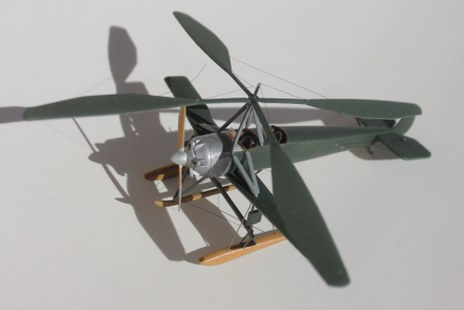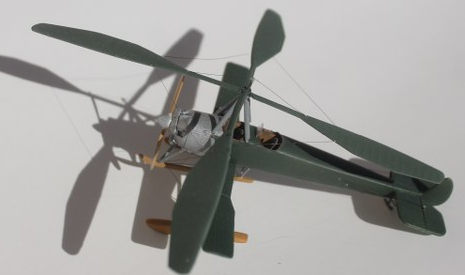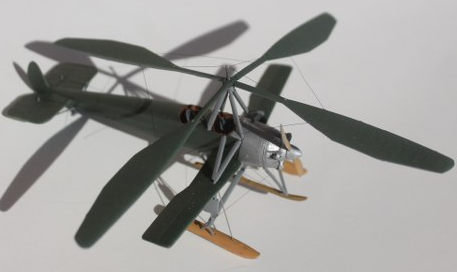
| KIT #: | 7279 |
| PRICE: | $12.90 |
| DECALS: | Not required |
| REVIEWER: | Brian Baker |
| NOTES: | Nice kit of an interesting aircraft. |

| HISTORY |
The earliest research in rotary
winged aircraft was carried out by Cierva in Spain in the 1920ís. License
production of the U-1, which was actually a conversion or the Avro 504, using
the fuselage for the prototype. Incidentally, this same Avro 504 conversion was
done in England in the late twenties, but the original Russian autogyro
prototype used a specially built fuselage, as was designated the
Kamov-Skrzhiunsky KAZSKR-1. This
 was flight tested near Moscow in 1929, using a
100 hp. M-2 radial engine. The KASKR-2 was an improved model, with some
aerodynamic refinements, noptably in the wings, rear fuselage, tail unit, and
other components. The powerplant was a 230 hp. M-2 radial engine, which was
similar to the Gnome-LeRhone Titan type radial, not rotary, engine.
was flight tested near Moscow in 1929, using a
100 hp. M-2 radial engine. The KASKR-2 was an improved model, with some
aerodynamic refinements, noptably in the wings, rear fuselage, tail unit, and
other components. The powerplant was a 230 hp. M-2 radial engine, which was
similar to the Gnome-LeRhone Titan type radial, not rotary, engine.
Flight tests were conducted between 1929 and 1931. The aircraft used a conventional small span wing with large ailerons, and had standard horizontal and vertical tail surfaces. An Avro 504 skid was retained under the fuselage, along with an Avro type landing gear. Some tests were carried out using skis instead of the standard wheeled landing gear. There is little information available on the number produced, or their service use. Most photos show unmarked aircraft, while one drawing shows some kind of Russian script on the fuselage side, probably some kind of political slogan.
| THE KIT |
The kit is obviously a spinoff from the companyís U-1 kit, which depicts the Russian-built version of the Avro 504. The first sprue contains the fuselage, landing gear, and the horizontal tail unit, and is similar to the production Avro. The second and third sprues provide the parts for the autogyro conversion. These include the rotor blades and struts, stub wings, prop, engine and firewall forward, and the ski landing gear. Photos show the aircraft with either wheels or skis installed, so that option exists. The skis are cast in two parts, so they are not just flat units.
| CONSTRUCTION |
First, assemble the cockpits. This
consists of two seats, and two instrument panels. If you are going to detail the
cockpit, since no real information is provided, it would be safe to assume that
it would be similar to that or
 an Avro 504. I created sidewall detail, and added
control sticks and rudder pedals. I painted the interior fabric color, with
brown for the wooden parts. Extra detailing is necessary because the cockpit is
easily visible from the outside.
an Avro 504. I created sidewall detail, and added
control sticks and rudder pedals. I painted the interior fabric color, with
brown for the wooden parts. Extra detailing is necessary because the cockpit is
easily visible from the outside.
Once the cockpit is completed and painted, the fuselage halves can be joined. Only a little filler is needed. Then the stub wings and tail unit can be installed. These should be painted at this stage, as there are many struts to be added for the landing gear and rotor blade assembly. The rotor blades should be installed with a definite negative dihedral angle, although they slant upwards in photos showing the aircraft in flight.
The rotor blades and struts can be attached before painting, as they can be painted dark green. The main rotor shaft appears to go straight down through the forward cockpit, which means that the pilot in the front cockpit had to straddle the shaft. I would have found that quite disconcerting to experience while the aircraft was in flight.
| COLORS & MARKINGS |
 The aircraft is overall dark green.
I used Model Master Russian Topside Green. The undersides of the fuselage and
tail surfaces are light grey/blue. I used underside Russian Light Blue. The
rotor blades are light grey, according to the instructions, but photos show them
dark green, so thatís what I used. The cowling ahead of the cockpits is
unpainted aluminum. There are no decals provided, and I have seen only one photo
with some kind of Russian writing on the side, probably ďStalin is a Good GuyĒ
or something similar. Itís in Russian, so nobody will ever know.
The aircraft is overall dark green.
I used Model Master Russian Topside Green. The undersides of the fuselage and
tail surfaces are light grey/blue. I used underside Russian Light Blue. The
rotor blades are light grey, according to the instructions, but photos show them
dark green, so thatís what I used. The cowling ahead of the cockpits is
unpainted aluminum. There are no decals provided, and I have seen only one photo
with some kind of Russian writing on the side, probably ďStalin is a Good GuyĒ
or something similar. Itís in Russian, so nobody will ever know.
| CONCLUSIONS |
This is a fun kit to build. There is a lot of detail, but this can be handled by modelers with even little experience. The result will be an unusual looking model that will stand out on your display shelves. I would highly recommend it. Itís a lot easier than doing the Airfix Avro 504 Cierva Autogyro conversion, which I have also done. But thatís another story.
| REFERENCES |
I found quite a bit of information on Google by just asking for information about the aircraft. There are some photos. I didnít find anything in my library of airplane books, so this seems to be the only source of information.
January 16, 2020
Copyright ModelingMadness.com
If you would like your product reviewed fairly and
fairly quickly, please
contact
the editor or see other details in the
Note to
Contributors. Back to the Main Page
Back to the Review
Index Page
Back to the Previews Index Page